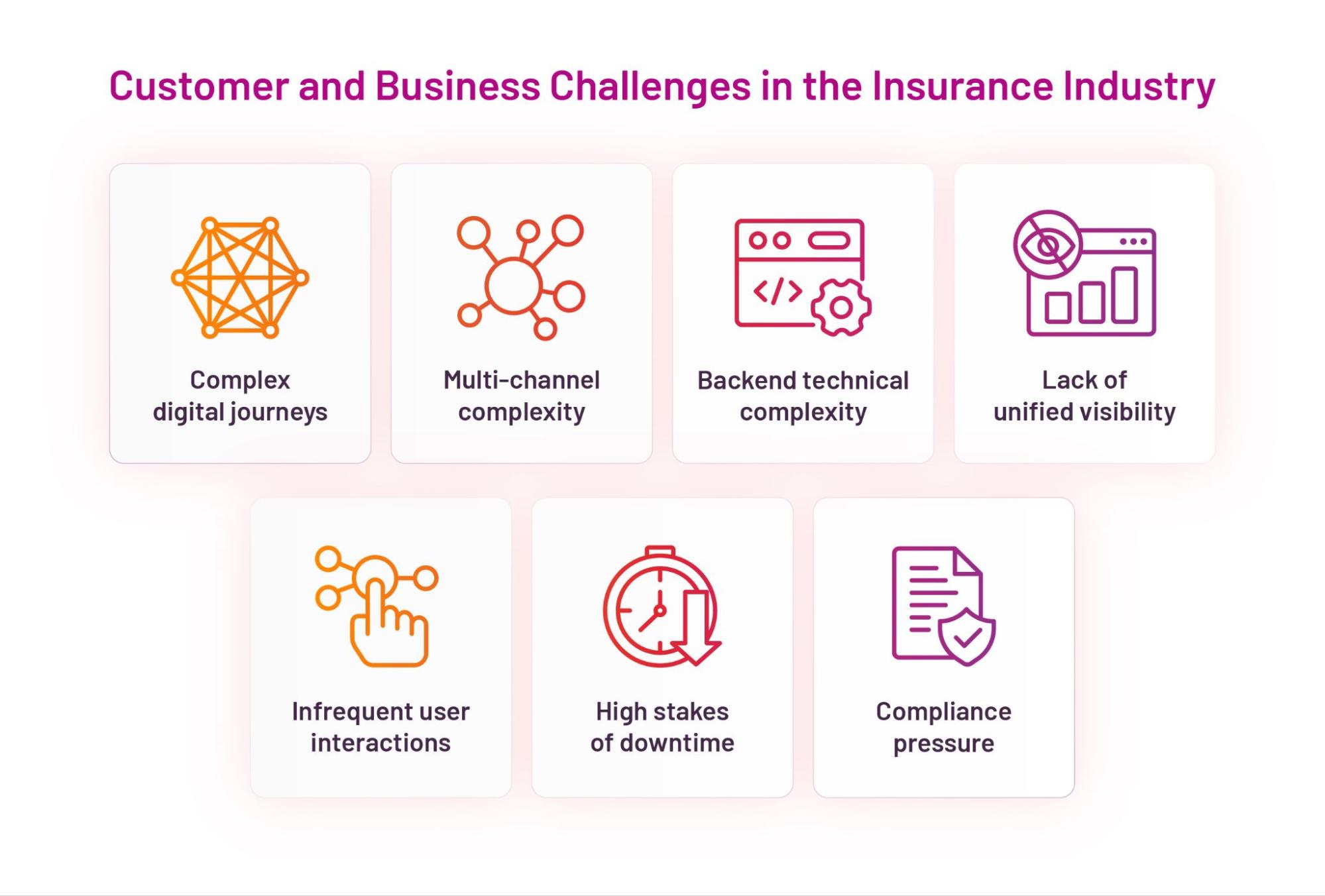Transforming Insurance Operations with Business Journey Observability
- Jul 9, 2025
- Blogs
- 7 min read
A Shift in the Insurance Industry
Insurance companies are becoming increasingly digital and even more fragile. Customers now expect instant quotes, seamless policy purchases, and self-service claim processing. They expect fast, transparent, and hassle-free experiences irrespective of how they access the insurers’ products – apps, aggregator platforms, service portals, or human agents.
When the customers experience a delay or failure, it isn’t just a technical issue—it’s lost trust, missed revenue, or a breach of regulatory obligations. The root cause is often the complex web of legacy systems, third-party APIs, and stringent compliance checks underlying the customer journeys.
India’s insurance industry is expected to double by FY31, driven by increasing awareness, innovative products and digitization. This volume growth will only increase the challenges the insurers are already facing, in addition to the rising regulatory expectations.
In this blog, we explore these challenges and how Business-centric Observability can address them, enabling insurers to gain end-to-end performance visibility while delivering a seamless digital experience for customers across all touchpoints.
Insurance Industry – Customer and Business Challenges
Today’s insurers deliver a wide range of digital services—policy purchase, renewals, claims submission, grievance redressal, and more—across web and mobile channels. However, they face significant challenges:


Fig1: Customer and Business Challenges in the Insurance Industry
- Complex digital journeys from quote to proposal to payment, where friction in any step can lead to drop-offs and lost business.
- Multi-channel complexity, as customers engage via apps, aggregators, agents and service platforms – each present unique monitoring challenges yet expect seamless experiences.
- Backend technical complexity, with journeys involving multiple handoffs between complex internal systems like CRM and underwriting, database operations and external APIs like KYC and payment gateways.
- Lack of unified visibility owing to complex system landscape and digital journeys, making it difficult to detect where issues affect policy issuance, renewals, or claims
- Infrequent but critical user interactions, where a customer interaction is limited to once or twice a month for renewals or claims, yet a single poor experience can adversely impact satisfaction and trust.
- High stakes of downtime, where even brief delays during claims or renewals can erode trust and increase attrition. E.g.: Applications timing out during policy purchase, or a motor insurance claim is stalled while uploading photos.
- Compliance pressure, especially around IRDAI mandates on availability, traceability, SLA adherence, and grievance handling
How and Why Current Monitoring Falls Short
To manage these unique complexities and the challenges arising from them, insurers typically rely on siloed APM or infra-monitoring tools. These tools focus on technical metrics alone, showing a spike in error logs or CPU usage, but not the number of claims dropped due to a verification service failure—or the number of high-value policy renewals that didn’t go through due to a slow third-party API. Further, they limit visibility into external dependencies (such as policy comparison sites or RTAs), complicating and delaying issue resolution.
Without correlating technical issues with customer and business outcomes, root cause analysis is delayed, issues are misdiagnosed, and teams remain in firefighting mode.
Given the complexities and challenges plaguing the insurers, they need end-to-end visibility across their customer journeys with real-time insights correlated to business outcomes. The answer lies in Business-centric Observability, and let’s see how.
From Complexity to Clarity: What VuNet’s Platform Does
VuNet’s Business-centric Observability platform offers a different approach to managing digital insurance operations. By providing end-to-end visibility across the customer journey with real-time business insights, it enables insurers to proactively identify and resolve customer-impacting issues.
Here’s how the platform works:
- Ingest and unify data across systems: Through OpenTelemetry, seamlessly connects to policy systems, apps, middleware, payment gateways, APIs, and third-party services to ingest logs, metrics, traces, and events into a single real-time view.
- Map and visualize full business journeys: Connects and creates journeys like quote-to-policy, renewals, claims, and grievances, tracing them to internal and external systems as well as 3rd party integrations – providing 360° visibility.


Fig 2: Insurance Journey Map
- Correlate technical signals with business KPIs: Maps API errors, latency, and infra degradation to customer abandonment, claim rejections, or failed transactions.
- Detect anomalies early using AI/ML: Spots unusual user patterns, silent failures, or sudden surges in drop-offs before they escalate.
- Drive real-time action and automation: Triggers context-rich alerts, enables instant RCA, and automates fallback responses.
- Forecast and Predict using AI/ML: Predict business impact of technical failures and plan capacity requirements for business preparedness and resilience.
- Ensure SLA compliance and audit readiness: Offers detailed, time-stamped traceability of journeys to support IRDAI and internal governance requirements.

Fig 3: Detailed, Time-stamped Traceability of Journeys
Key Use Cases Where VuNet Makes a Difference
- Policy Renewal & Premium Payments
Pinpoint exactly where renewals are failing—whether due to a broken payment flow, slow quote retrieval, or silent backend errors. Fix what matters in real time. - Claim Initiation and Tracking
Trace the complete digital claim process—from FNOL (First Notification of Loss) to document uploads, verification, and settlement. Identify where claims get stuck and streamline experiences. - New Policy Issuance
Ensure smooth onboarding and policy issuance by identifying failures in customer KYC, API integrations, or underwriting workflows. - Grievance and Service Requests
Monitor the status of customer service journeys like complaints or status checks. Catch SLA breaches early and improve service outcomes.
Benefits: More Than Just Monitoring
- Faster Issue Resolution
Quickly find and fix problems with a single, unified view of the entire customer journey. This dramatically cuts down response time, reduces failed transactions, and improves service uptime. - Visibility into Partner Systems and Ecosystem Dependencies
Track external partners like payment gateways, banks, UIDAI, CKYC, and telecom services. Know instantly when a partner system fails or slows down—and act fast to switch or inform customers. - Customer-Centric KPIs Aligned with Journeys
Measure experience and business outcomes —like policy issuance success, claim turnaround time, or SIP completion—not just technical metrics. Business and IT teams work together on business outcomes and KPIs. - Improved Customer Experience and Trust
With faster resolutions and fewer disruptions, customers get a smoother experience. Support teams also have real-time answers, boosting confidence and satisfaction. - Cross-Team Collaboration and Accountability
Everyone sees the same real-time view—IT, operations, and business. This improves collaboration, speeds decision-making, and ensures everyone is working toward the same goals.
Conclusion: See What Matters, Fix What Matters
Insurance companies operate in an increasingly digital and real-time world where every moment counts. With customers demanding a seamless experience and a complex system landscape going beyond the boundaries of insurers, traditional monitoring is no longer sufficient. It is time to embrace Business-centric Observability to gain complete visibility across the complex landscape and proactively manage customer journeys.
With VuNet’s Business-centric Observability, insurers can make this shift and set a benchmark in delivering an exceptional digital experience to customers.
Are you ready to ensure that every policy renewal, every claim, and every click contributes to a smooth and positive journey for the customer?
Talk to us to know more!
Table of Contents
- A Shift in the Insurance Industry
- Insurance Industry – Customer and Business Challenges
- How and Why Current Monitoring Falls Short
- From Complexity to Clarity What VuNet’s Platform Does
- Key Use Cases Where VuNet Makes a Difference
- Benefits More Than Just Monitoring
- Conclusion See What Matters, Fix What Matters










